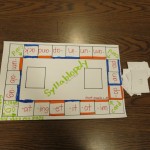 Let’s face it. Kids would rather play a game than do your blending lesson worksheet. Make Syllabllopoly! I’ve added the first 19 short vowel clusters to squares around the blank gameboard (it’s the maximum size for our copier, 11×17″; make lots so you don’t have to ever do that twice). Put initial sounds on the cards (3×5 cards cut in half). Color half the squares orange and half the squares blue, adding extra lines on 3 squares. Grab a die.
Let’s face it. Kids would rather play a game than do your blending lesson worksheet. Make Syllabllopoly! I’ve added the first 19 short vowel clusters to squares around the blank gameboard (it’s the maximum size for our copier, 11×17″; make lots so you don’t have to ever do that twice). Put initial sounds on the cards (3×5 cards cut in half). Color half the squares orange and half the squares blue, adding extra lines on 3 squares. Grab a die.
Player A and B both get 2 initial sound cards to begin, and the remaining cards go in a draw pile in the center. Both place a player marker on Go. Player A rolls die, moves that number of spaces, and says the vowel cluster they land on. Player A and his/her team try making a real word (names count as real words) using the initial sound with the vowel cluster. If they are successful, they get 10 points.
Player B rolls die, moves that number of spaces, and says the vowel cluster they land on. Player B and his/her team try making a real word (names count as real words) using the initial sound with the vowel cluster. If they are successful, they get 10 points AND another initial sound card from the draw pile.
If player lands on a square with 2 (or 3) colored sides, and if they can make 2 (or 3) words instead of just one, they get 20 (or 30) points.
Player who is ahead in points at the end of a pre-set time limit wins.




